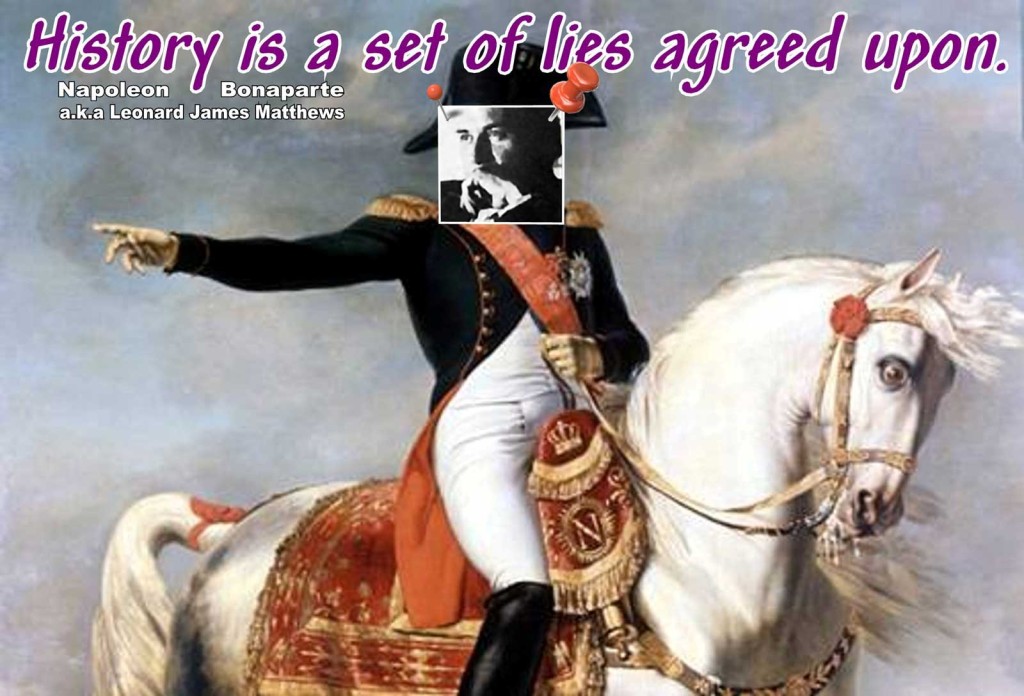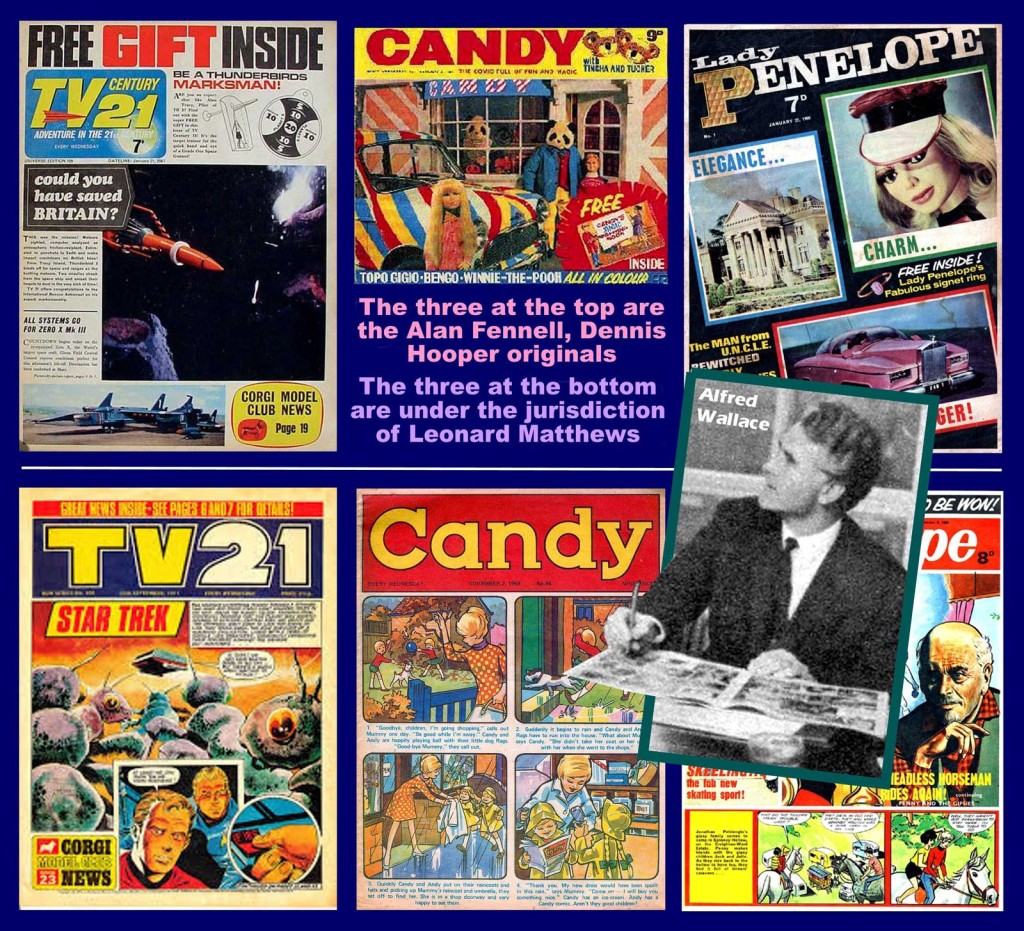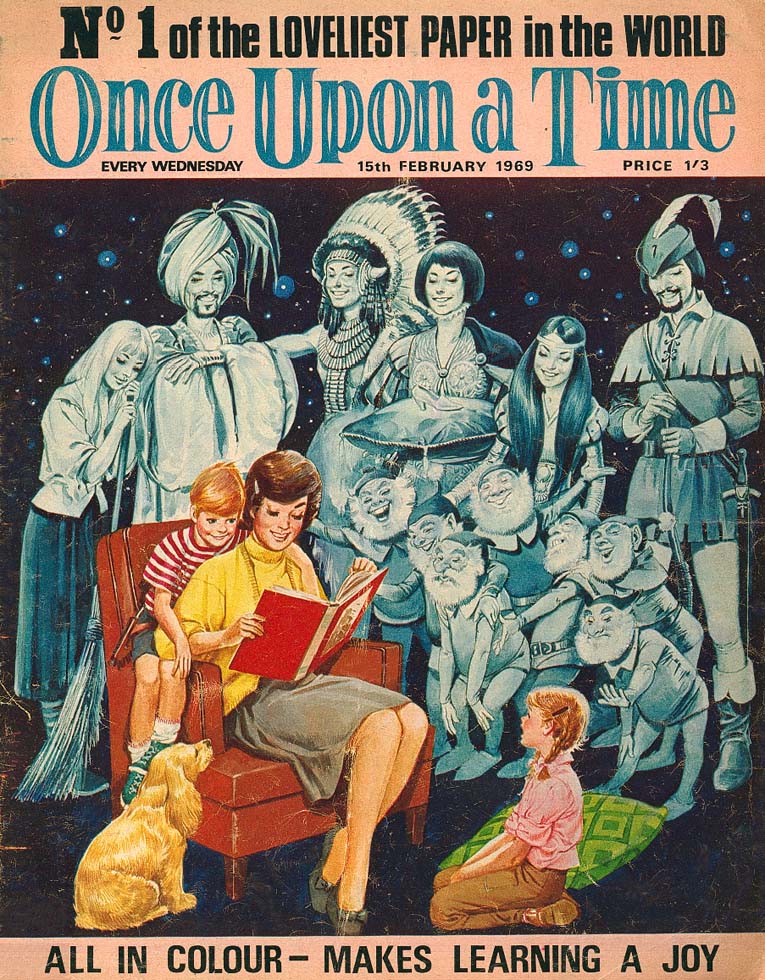Leonard Matthews, General Managing Editor of Fleetway and the Eagle Group of Comics, was a Creative Visionary… but that, Roger Perry argues in his extensive biography of the man which continues here on downthetubes, is only due to him having utilised the ideas of others.
Here, Roger recalls the creation of Martspress, the company that would publish TV21 in its later, cheaper incarnation…
An Unjustified Loathing for Waterloo…
1967
Despite his highly-elevated position within the company and his equally bullish personality, Leonard Matthews still felt he’d had no option but to leave Fleetway Publications. In his obituary, George Beal (Matthews’ life-long friend) noted that he would shortly have been able to have taken early retirement in any case. But this was something which I felt hadn’t been entirely true – not unless people are normally able to retire at the tender age of 53.
You could quickly interject with the possibility of his longevity of service, but then, in 1938 when he first joined the Amalgamated Press, Matthews was already 24 years old. Unlike those 14 or 15 year olds who begin their careers as office boys, it is they whose service and loyalty to a company is ultimately a great deal longer.
Towards the tail-end of 1967 and tipping over into 1968, Matthews began to ramp up his operations with a company called Martspress. But Martspress didn’t publish comics (or books) as such – it was a business concern whereby it packaged items for other publishers who were in the same line of business – companies the likes of City Magazines, publishers of well-known 1960s comics such as TV Century 21 and Lady Penelope (about whom I shall come back to in just a moment).
I first heard about Martspress while working as the Art Editor for the books and annuals section of Century 21 Publishing. I had assumed that Leonard Matthews had carried out all the nitty-gritty of putting Martspress together during 1967 and 1968 – in the months prior to his “retirement”… in fact, I had already begun to write this down believing that it had been a gospel fact. But not so. I was in the throes of putting this article together when, for some obscure reason, I decided to check Martspress out on the company register at Companies House – and to my surprise, discovered it had in fact been formed on 3rd July 1962, five-and-a-half years earlier.
I’ll tell you quite frankly that this was all new to me – and quite a bolt from the blue.
This discovery led me to Steve Holland’s excellent account of the history of Look and Learn (PDF), where he notes Martspress was set up in partnership with Velio Vuolo, a Italian who had been packaging pocket libraries from Spanish and Italian series for publication in the UK in the very early 1960s, but these came to a sudden end when their distributor went into liquidation. Vuolo teamed up with Leonard Matthews, who took a controlling interest in Martspress..
You will read later on in this piece that I had the occasion to visit Martspress in June 1969 when my own job at Century 21 Publishing had been on the line. During my brief fifteen-minute visit, I was introduced to Velio Vuolo and cannot say that I had warmed towards the man in any way… but then, that might have been due to my own somewhat negative mood at that somewhat depressing time.
The Martspress company’s registry number is 00728667 and is listed as being a business concern for Book Publishing. Curiouser and curiouser, I thought… particularly if you look up the details of cash, net worth, assets, liabilities, staff etc, etc, etc, for each column has placed upon it in very large standy-out letters (as one female friend used to jokingly say): NOT FILED… NOT FILED… NOT FILED.
Leonard James Matthews is listed as having been the director but that he had resigned on the 9th November, 1997 (which, incidentally, was the date of his death). It also shows that one Audrey Elizabeth Flower (I had forgotten that Elizabeth’s first given name was Audrey) – was listed as Company Secretary and that she too had resigned (but this was 18 days later, on the 27th November, 1997).
The report notes Barbara Mary Matthews (Leonard’s wife) became the new director on that latter-mentioned date, and to take on the role of the new Company Secretary, Josephine Rose Howe (presumably, Leonard’s daughter) is mentioned.
The company has now been dissolved, but no date of dissolution is listed.
One does need to wonder whether Matthews’ latest venture (now known to be first thought of in 1962) hadn’t been prompted by his outrageous antics during 1961 – particularly those that took place, as previously recounted, on Tuesday 5th September (lovingly referred to as “The Knockover” by authors Michael Moorcock, Harry Harrison and David Motton). Is it possible that his manic actions during that year – not just “The Knockover” itself but also later other weird bees-in-his-bonnet, such as the Dr James Hemming fiasco, but other petty carping – had not been viewed quite so favourably by various boards of directors?
Had the-powers-that-be also been shocked and horrified over the catastrophic outcome of the meeting that had taken place on that inauspicious day? The loss of staff was one thing, but the subsequent loss of 150,000 weekly sales must have been quite another (for this must surely have hurt pockets a good deal more than anything the high cost of running Eagle had done). Had the events of “Knockover” Tuesday resulted in a steady decline in Matthews’ popularity from that moment on?
Hmm. Perhaps I was correct when I’d said in Part Seven that Leonard Matthews had crawled off somewhere and was, possibly, now licking at his wounds.
The timing of the launching of Matthews’ Martspress could be considered as being particularly dodgy. Sales of comics generally across the board were steadily on the decline and there had been no six-week-long-printers’-strike to help to filter out any lame ducks. Was it that there were just too many of these fine periodicals about for youngsters to choose from, or had kids found some other form of interest to occupy their furtive minds?
Perhaps one juicy carrot being offered to Matthews – and one that had given him the encouragement to take this drastic leap into the dark – was the imminent collapse of TV producer Gerry Anderson’s Supermarionation empire (and that the subsequent dismantling of it was on the cards).
Setbacks for Century 21 Productions (Century 21 Publishing’s mother company, where I was then working) began coming to light with a decline in interest in Supermarionation… highlighted when the Thunderbirds are Go feature film, released in late 1966, proved a box-office flop.
Problems continued when ITC’s Lew Grade failed to sell the second Thunderbirds TV series to US broadcasters, and recommended that despite six episodes already ‘in-the-can’ and ready for immediate transmission, Gerry Anderson should cancel all further work on Thunderbirds in favour of a new series – which would be Captain Scarlet.
Slowly but surely, the wheels came off an extremely successful bus, with Thunderbird 6 being another box office failure and Gerry’s post-Thunderbirds shows unable to capture as many young imaginations in the way International Rescue had done, despite the technical prowess of their creation.
After Captain Scarlet and Joe 90, and the Thunderbird 6 feature, the final straw for the group, along with Anderson’s long-held desire to move to live action, was the cancellation of The Secret Service (itself an odd mix of live action with Supermarionation, part-way through filming, in December 1968, after Lew Grade saw the a test screening of the first episode.
Coincidentally, this was the same month Leonard Matthews took his leave of Fleetway/ IPC and moved full time to Martspress.
The TV mogul was unhappy over what he had called, the series’ un-sellable content, which was all to do with the language of Unwinese… as uttered by the series’ main star, ‘Professor’ Stanley Unwin (and something that was used extensively throughout the show). According to Grade, it would have been utterly incomprehensible to American audiences (mind you, I had thought that that had been the whole point of Stanley Unwin’s character – that what he said was incomprehensible to Americans, Brits and even the New Zealander Maori!).
(Actor Jon Pertwee would often later recount a similar problem with the sell-in of his popular Worzel Gummidge series, which US executives would sagely tell its bemused producers, aware of the show’s success everywhere else on the planet, would be “incomprehensible” to their viewers).
In a word, Lew Grade had become very twitchy over the way things were preceding in the studios of down-town Slough where the later Supermarionation shows were made. The show was cancelled and Century 21 Studios in Slough closed down on 24th January 1969 on completion of the final episode of The Secret Service, “More Haste Less Speed”.
It is likely that Alan Fennell (General Managing Editor of Century 21 Publications) and Tod Sullivan (Century 21 Publications Script Editor) had both had far closer a relationship with Matthews than anything I had ever known about… perhaps understandably so, when one considers that during the latter half of the 1950s, they had all rubbed shoulders while working within the corridors of Fleetway House. With cards being placed on the table, Anderson’s spokespersons (Fennell and Sullivan) did a deal with Matthews that not only saw Martspress taking over the Century 21 papers, but also some of the Century 21 Publishing staff – the likes of John Ayres and Peter Cori – moving to Matthews’ company as part of the new deal.
Although the comics department had originally been housed in the same building as the books section at Century 21, because they were on the Fifth floor it just so happened that nobody gave any thought to letting us know in the book department as to what was going on up on the Eighth. It was only by the time that the comics department had already physically upped and gone over to Martspress that we heard about it… and by then, it had been a bald case of fait accompli.
I did eventually learn however – about a year later, when my own job was on the line – that working for Matthews at Martspress had not been altogether such a rosy experience. In June 1969 when all those in the book section had also been obliged to work out their one month redundancy notices that I went along to Martspress on the off-chance that they might have a vacancy.
I was surprised to find Alfred Wallace (ex Managing Editor of Eagle, et al) there, looking somewhat ‘lost and forlorn’ – and was even more surprised when he actually spoke to me. In the three-and-a-half years that my office had butted onto his, both at the Hulton House Annex and then at 96 Long Acre, I doubt very much if we exchanged more than three words in total in all that time. Now that Eagle had been merged with Lion, Alf had found himself at a loose end and had decided to throw in his chips with Matthews… although doing exactly what was anyone’s guess (for it was well-known that he hadn’t done much (if anything) while on Eagle either).
However, I suppose I ought to offer some sympathy for the poor fellow – first he lost his 27-year-old son through drug-abuse, and then while taking something down from a top shelf in his garage, he lost his balance; had fallen off the short pair of steps he was standing on; and had fractured his right wrist so badly that he was never able to write properly ever again.
Just as I was leaving Martspress that day, both John Ayres (ex-art editor Dennis Hooper’s assistant at Century 21) and Peter Cori (assistant to the ex-art editor’s assistant) shot out of a side room to have a quick word, saying that not only were the working conditions pretty bad there but they were being forced to buy their own equipment also – pencils, pens, paintbrushes etc., which was not normally the practice while working at an art studio.
So I now come back to ask myself the same question Why? Why would Matthews have left such a prestigious position as Director of Fleetway Publications even before he’d reached his mid-fifties? Had the overlords at Fleetway discovered his penchant for dipping his own hands into Fleetway’s freebie money-pot as so many others had done (I will give my reasons for having said this in just a moment)… or did someone at Fleetway unfavourably recount his antics to other directors for doing what he had done? After all, there was no doubt that he must have made a few enemies because of them.
But before I go into this latter pair of possibilities, there could well have been something else that had persuaded Matthews to resign – something that was actually quite bizarre… but I do need to point out that this is pure conjecture on my part.
The Fleetway Publications building was literally bursting at its seams. There were just too many magazines and too many staff to be contained within the one building. Brian Woodford – of whom I have spoken many times – has mentioned having erected pre-fabricated buildings on the roof of Fleetway House that were accessed by the fire escape, and he has also spoken of other offices in such places as John Carpenter Street as there had been no room to house them all at Old Fleetway House. So in a mass migration, magazines and staff alike were transferred over to a brand new high-rise office block called King’s Reach Tower.
At the very start of these articles on Leonard James Matthews – in Part One – I said this:
It was also being said that despite him living in Esher, under no circumstances would Matthews concede to using the main line railway station at Waterloo.
One does have to wonder whether the positioning of the King’s Reach high-rise office block hadn’t had something to do with his decision in wanting to retire ‘early’… for this new building is, after all, right on the door-step and across the road from the Waterloo Mainline Railway Station’s front door. Now you might think me crackers to even suggest it, but then, you haven’t finished reading this article yet. And when you have, I shall ask you this question again.
So the burning question is, did Matthews resign? Was he sacked, because he had been rumbled (and this is something that I will come back to in just a minute)? Or had he just opted to take early ‘retirement’ before the proverbial brown stuff hit the fan-blades?
Who knows what the real reason behind it all had been! What you do have to remember is that when he departed Fleetway to begin running his own packaging company from offices just off Fleet Street, he was still only 53 years old.
1968
Who were Matthews’ possible enemies at Fleetway Publications? Well, here’s a tale on that front that I feel well worth relating. While Century 21 Publishing was still housed within the City Magazines building in Fleet Street, Howard Elson – who had transferred from the comics division and up to the books section on the Eighth floor (to work alongside Art Assistants Andrew Harrison and Bob Read, Sub Editor Linda Wheway and myself) – had commissioned John Sanders (of Fleetway Publications, who was still working on Ranger) to write a story that ultimately was destined to be published as a paperback in the Thunderbirds / Lady Penelope format.
Following the receipt of the finished manuscript, according to Howard, he placed a call to Sanders saying that his story really wasn’t good enough and therefore he was about to reject it. I have no idea as to what had been said, but when the verbal exchange had finally come to an abrupt end, Howard came over to me – somewhat white-faced – saying that on signing off, Sanders had disclosed the fact that he’d recorded the telephonic call and that if Howard wished to proceed with the rejection of his work, then Sanders would take matters into his own hands and personally sue him.
Due to Century 21 Publishing’s comic section having been transferred over to Martspress, Howard had opted to join Robert T Prior, Andy Harrison, Linda Wheway and me on books. However, it was Howard who took it upon himself to make direct contact with Sanders – someone who I had not previously heard of anyway – and so all Andy, Linda and I could really do was to raise the odd eyebrow and do little more than sympathise.
This recording of conversations does, however, lead me to wonder if, somehow, Sanders also had something on Matthews.
Prior to being handed TV21, Lady Penelope and Candy on a plate – which had been somewhere around June or July of 1968 – Matthews had already devoted almost all his attention into producing material as a packager for any publisher who required and wished to pay for it. The first among such publications was the comic Once Upon a Time, published by City Magazines which was launched on 15th February 1969.
There’s no doubt that during his time at Amalgamated Press, Fleetway and then IPC Matthews and his editorial team recruited many established artists from outside the world of comics to work on many of the titles – as comics archivist Peter Gray notes in his post on the origins of Once Upon A Time, many already having become famous as top book illustrators. Some of them worked on one of Matthews final creations for Fleetway – a joint Dutch-English venture along the same lines as Look and Learn, Tell Me Why. Launched on 31st August 1968 and subtitled “The World of Adventure – In Living Colour,” Steve Holland notes Tell Me Why was even more visually oriented than Look and Learn.
“Because of the care Matthews took over the look of his titles he quickly became known as ‘The Artist’s Editor’,” says Gray, “inspiring intense loyalty in many of his own protégés as he repaid them with a paternalistic concern for their own welfare (though he could be less than generous with artists like the troubled Frank Hampson who came from outside his own stable).
Matthews’ new creation Once Upon A Time, its contents built primarily around fairy stories and tales that would attract the same audience as Look and Learn‘s junior, Treasure, attracted a stellar line-up of contributors, including Jesus Blasco, Don Lawrence, Ron and Gerry Embleton, Angus McBride, José Ortiz and many others.
In Part Nine, from the sublime to the ridiculous, Men Only is given a new lease of life…
Roger Perry
The Philippines
Acknowledgments to David Slinn and to Darren Evens of Eagle Times for producing certain scans as used in this article.
[divider]
Web Links
• The History of Look and Learn by Steve Holland (PDF)
• Martspress Company Record at DueDil (registration required for full information) – Companies House record not available at time of posting
• Sharon’s Sunlit Memories Blog
This delightful site features a number of posts devoted to the work of Ron Embleton, who not only worked on TV Century 21 and many other titles, but is mentioned here for his work on Once Upon A Time
• The World of Stanley Unwin
Hi ho and a jolly welcode to all you surfwide’n interwebber lopers. Here beholdy manifold things Stanley Unwinmost – all deep joy and thorkus for great laugh’n tittery. O yes. Includes a guide to Unwinese
More Eagle Daze
• Eagle Daze: The Life and Times of Leonard James Matthews – Part One
Roger explores the beginnings of the destruction of the Eagle…
• Eagle Daze: The Life and Times of Leonard James Matthews – Part Two
The comic magazine Top Spot, published in 1958, was Matthews’ brainchild – but it was the male counterpart of an already existing magazine and it was a title that faced plenty of problems as it ran its course before merging with Film Fun after just 58 issues…
• Eagle Daze: The Life and Times of Leonard James Matthews – Part Three
Roger outlines how Matthews jealousy almost destroyed the Eagle…
• Eagle Daze: The Life and Times of Leonard James Matthews – Part Four
Roger reveals a possible mole working on the Eagle and trouble behind the scenes on Girl…
• Eagle Daze: The Life and Times of Leonard James Matthews – Part Five
How a Marks & Spencer Floor Detective Became Managing Editor of Eagle…
• Eagle Daze: The Life and Times of Leonard James Matthews – Part Six
Roger reveals how Dan Dare co-creator Frank Hampson was thorn in Leonard Matthews side…
• Eagle Daze: The Life and Times of Leonard James Matthews – Part Seven
Trouble at the top for ‘The Management”, the troubled debut of Boys’ World – and the demise of Ranger
• Eagle Daze: The Life and Times of Leonard James Matthews – Part Eight
On the creation of Martspress, the company that would publish TV21 in its later, cheaper incarnation…
• Eagle Daze: The Life and Times of Leonard James Matthews – Part Nine
Moving from the sublime to the ridiculous, Roger recalls how Men Only was given a new lease of life – and Leonard Matthews’ ignorance of Star Wars…
• Eagle Daze: The Life and Times of Leonard James Matthews – Part Ten
A phone-call out of the blue brings about a closer relationship with the one man Roger had once feared the most…
• Eagle Daze: The Life and Times of Leonard James Matthews – Part Eleven
A search for elusive promotional film stills end in the middle of nowhere in a one horse town without a horse – and Eagle‘s production methods are recalled
• Eagle Daze: The Life and Times of Leonard James Matthews – Part Twelve
Roger clarifies points made in past chapters, looks back on Leonard Matthews career – and sums up his contribution to British comics – and publishing in general…
[divider]
This article, which is being published in a total of 12 parts, has been put together using material from Leonard Matthews’ obituary as written by George Beal for the Independent newspaper dated Friday, 5th December 1997; also taken from the Independent newspaper dated Sunday, 23rd October 2011 is a piece authored by Jack Adrian (a.k.a. Christopher Lowder); Living with Eagles compiled and written by Sally Morris and Jan Hallwood (particularly pages 219 to 222); David Slinn’s research notes during 2005 in connection with the authoring of Alastair Crompton’s Tomorrow Revisited and from Brian Woodford’s association with Matthews at the Amalgamated Press between 1955 and 1962. Entries also come from both Wikipedia and from the internet under the heading Fleetway Publications.
Further pieces have been taken from Eagle Times as and where identified; the blog-spots of Michael Moorcock’s Miscellany (particularly 9th and 10th April 2013) and Lew Stringer’s Blimey! where he refers to the Top Spot magazine. The remainder is from my own personal association with Leonard Matthews between the years of 1978 and 1991.
• You can read Roger Perry’s full biography here on Bear Alley
Artist, designer, photographer and writer Roger Prölss Perry was the youngest of three children – the given name of Prölss deriving from the maiden name of his paternal German grandmother.
Born in Guildford, Surrey in July 1938, after school he studied at the Regent Street Polytechnic School of Art close to Oxford Circus, the West End and the BBC where he achieved the National Diploma in Arts and Design before commencing with a further year of study in commercial design under the guidance of Ley Kenyon DFC, noted for his writing, art and underwater photography, and lithographer Henry Houghton Trivick (1908-1982).
His first job in the media industry was as an in-house illustrator on Farmers’ Weekly, beginning in March 1959, working under the direction of Art Editor Alfred Harwood, working on the seventh floor of Hulton House at 161-167 Fleet Street, London. He was there for just five months before going into two years of National Service until August 1961, returning to the company (now Long Acre Press) as a layout artist (designer) at “Juvenile Publications”, the umbrella name for Eagle, Girl, Swift and Robin. He joined the team of three other layout artists – Bruce Smith, Ron Morley and John Kingsford – on Monday, 28th August 1961 where he remained until May 1966.
He then began work as Art Editor at Century 21 Publishing until June 1969. As he says: “Yes, I suppose I could be described as a ‘layout artist’ but I commissioned art (Art Editor), kept an eye on Andrew Harrison and Bob Reed (Studio Manager), took photographs as and when needed (Resident Photographer) and generally made sure that everything was present and correct when everything needed was being sent to the printer (Office Boy). I also (with the help of Linda Wheway) came up with the ideas and photographs for five books (Author?)”.
From Century 21 Publishing, Perry then went to Hamlyn Books (July 1969 to October 1970); and worked for Bob Prior’s premium packages for two months before joining ex-Art Editor of Century 21 Publishing Dennis Hooper in December 1970 who was now Editor of Countdown at Polystyle Publications.
Perry remained with Polystyle until September 1974, when he became Art Editor for Purnell Books, remaining with the publisher for eleven years – until 1985 when he started operating his own public relations business.
Due to his growing interest in the art and the close proximity of Bath where the nerve centre of the Royal Photographic Society is, he achieved the distinction of Associate Member in 1987 for audio/ visual presentations thus entitling him to display the letters ARPS after his name… although he rarely does.
Having had a life-long fascination for the Far East, he moved to the Philippines in the 1990s, where he married Marilyn Gesmundo. He lived for 11 years on Cataduanes before moving a number of times recently following Typhoon Haiyan, finally with Raquelyn Navarro in the city of Naga in Cebu.
Sadly, Roger died on 23rd July 2016 following a heart attack, just one day after his 78th birthday.
He is survived by his daughter, Rae. His son, Marcus, predeceased him after a long battle with cancer.
Categories: British Comics, Creating Comics, Features







 Crowdfunding Spotlight: Who Killed Nessie? A Quick Chat with Paul Cornell & Rachael Smith
Crowdfunding Spotlight: Who Killed Nessie? A Quick Chat with Paul Cornell & Rachael Smith  Who remembers Jerry Siegel’s British superheroes,”Gadgetman and Gimmick-Kid”?
Who remembers Jerry Siegel’s British superheroes,”Gadgetman and Gimmick-Kid”?  Battle (and Action) – The Return: The Story So Far…..
Battle (and Action) – The Return: The Story So Far…..  Paul Neary – Hero Unlimited
Paul Neary – Hero Unlimited